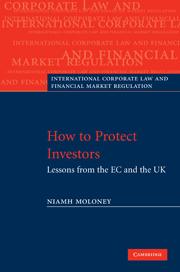Book contents
- Frontmatter
- Contents
- Preface and acknowledgments
- Table of cases
- Table of treaties and legislation
- List of abbreviations
- 1 The retail investor and the EC
- 2 Designing a retail investor protection regime
- 3 Product regulation
- 4 Investment advice and product distribution
- 5 Disclosure
- 6 The trading process
- 7 Education and governance
- 8 Supervision, enforcement and redress
- Index
- References
8 - Supervision, enforcement and redress
Published online by Cambridge University Press: 26 February 2010
- Frontmatter
- Contents
- Preface and acknowledgments
- Table of cases
- Table of treaties and legislation
- List of abbreviations
- 1 The retail investor and the EC
- 2 Designing a retail investor protection regime
- 3 Product regulation
- 4 Investment advice and product distribution
- 5 Disclosure
- 6 The trading process
- 7 Education and governance
- 8 Supervision, enforcement and redress
- Index
- References
Summary
Public supervision and enforcement in the retail markets
Public supervision and enforcement in the retail markets
The mounting evidence on the relationship between ‘law in action’, in terms of supervision and enforcement, and strong financial markets is primarily concerned with capital-raising and cannot be directly transplanted to the retail markets. Nonetheless, the intuition that strong retail markets demand robust ‘law in action’ in the form of effective supervision and enforcement is reasonable, not least given the difficulties of private enforcement (section II below). There appears to be a link between participation and effective enforcement; investor trust, strongly associated with engagement, has been related to the perception that market actors comply with regulation. The connection between supervision/enforcement and engagement is also reflected in the inclusion of compliance and trust-in-enforcement indicators in the Commission's Consumer Markets Scoreboard, while CESR's deepening dialogue with the retail sector also suggests stakeholders' concern with enforcement.
The EC regime
The EC's investor protection regime is based on a public supervision and enforcement model; EC private redress initiatives, while developing, remain tentative. Pan-EC supervision, at present, is based on mutual recognition of domestic supervision. Domestic supervisors, operating under a home Member State control model, supervise their firms' pan-EC activities. There are some exceptions. Under MiFID, branch compliance with conduct-of-business, best execution, order handling and transparency requirements, but not conflict-of-interest rules, is supervised by the Member State in which the branch is situated (Article 32(7)).
- Type
- Chapter
- Information
- How to Protect InvestorsLessons from the EC and the UK, pp. 426 - 463Publisher: Cambridge University PressPrint publication year: 2010

